Order Buxales / Boxwood Flowers
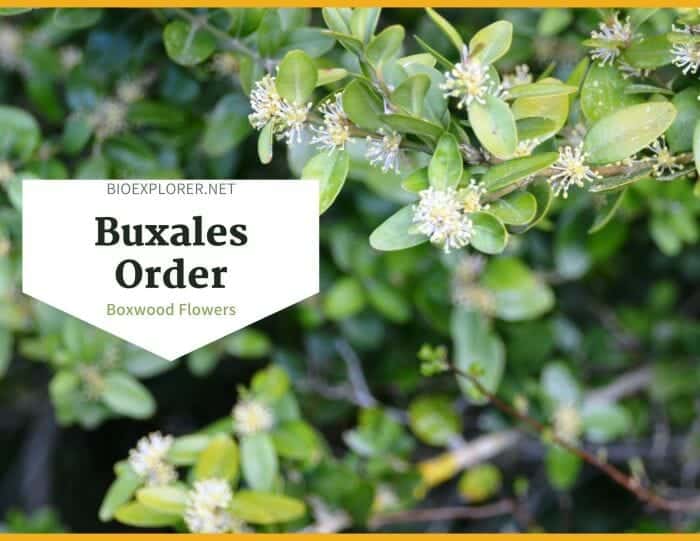
Order Buxales is the eudicot flowering plant consisting of evergreen shrubs or trees. It is usually found in the tropics and subtropics. Members of Buxales are usually monoeciousWhat is monoecious?Pertaining to plants, individuals of which bear both staminate and pistillate flowers, but not necessarily perfect flowers. with simple, non-sheathing, and estipulate leaves.
The Buxales flowers are actinomorphicWhat is actinomorphic?A characteristic of the flower exhibiting radial symmetry such as starfish or Daisy flower; capable of being bisected into identical halves along more than one axis, forming mirror images. Opposite is Zygomorphic., hypogynous, possess an inconspicuous perianth. The female flower’s style is stigmatic for its full length. The Allegheny spurge and the Christmas box are example plants belonging to order Buxales.
Jump to:
Buxales Families
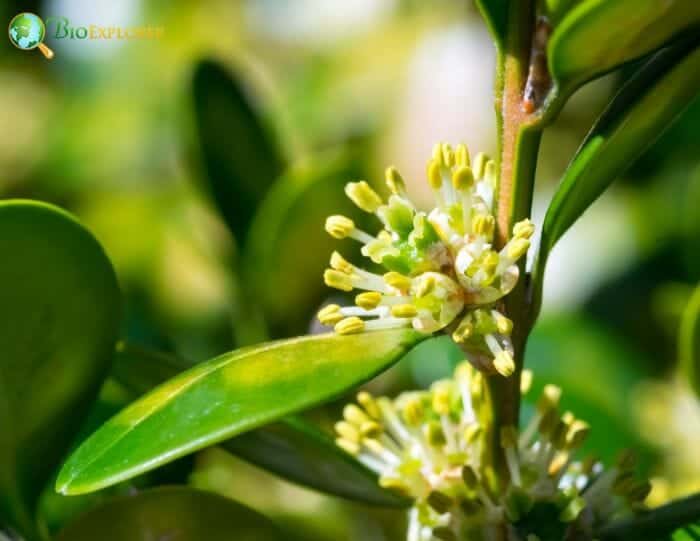
Buxales is a small order recognized by the APG IV system, consisting of 1 family, 6 genera, and 140 species[1]. The sole family under Buxales is Buxaceae.
- Previous classifications include the other 2 families, Haptanthaceae and Didymelaceae.
- However, Didymelaceae was not recognized by the APG III system, but the genus Didymeles was incorporated in the Buxaceae. Additionally, the APG IV system in 2016 also incorporated Haptanthaceae into Buxaceae.
- This leaves Buxaceae as the only family under Buxales.
![]()
Buxales Distribution
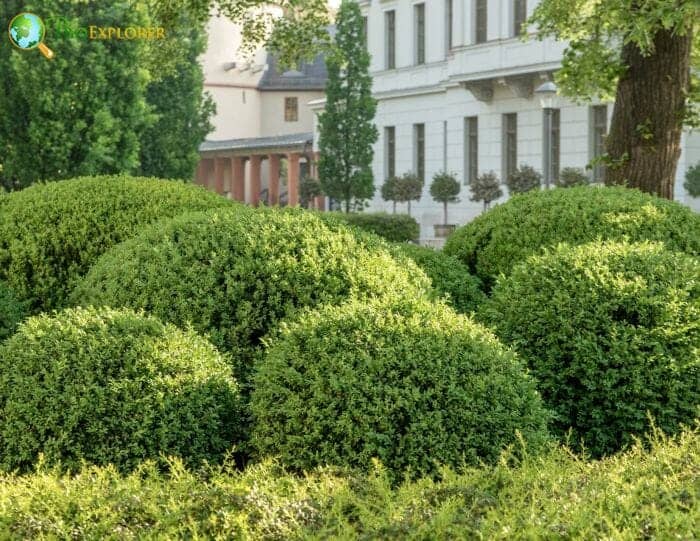
Genus Buxus, commonly called Boxwood, is usually found in the tropics and subtropics.
- They are also distributed in western and southern Europe, Madagascar, South and Central America, and Mexico.
- Some species are also native in Asia and Africa. Genus Didymeles has a restricted distribution to Madagascar and the Comoro Islands. The Haptanthus, with 1 species, is found in Honduras.
- The species of Pachysandra are growing in southeastern North America and eastern Asia. The Sweetbox or Genus Sarcococca is distributed in eastern and southeastern Asia. They are also natives of the Himalayas.
- Members of the genus Styloceras are found in South America.
![]()
Buxales Characteristics
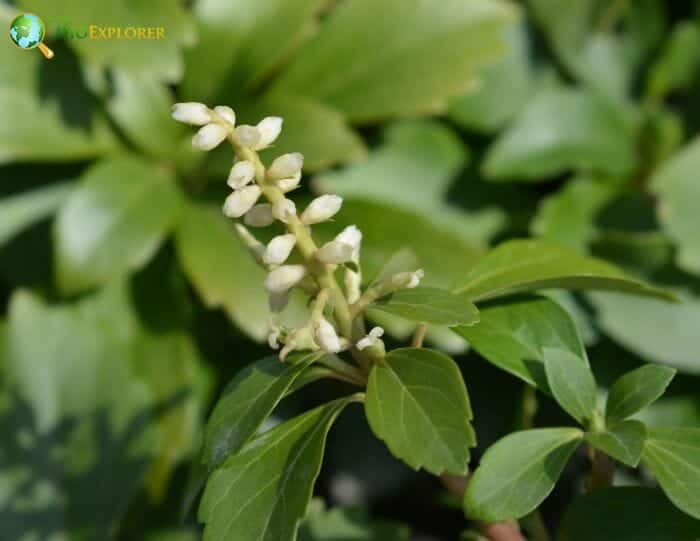
The following characteristics are shared by the members of the order Buxales:
- Plant type: Members are evergreen shrubs or trees. A few species are rhizomatousWhat is rhizomatous?Bearing rhizomes. Rhizome is an underground stem, with nodes and short to elongate internodes. perennial herbs.
- Stem: The members have cork cambium. The internal phloem is absent. The Buxales plants usually have cortical bundles. The vessles are present or absent in the axial xylem.
- Leaves: The leaves are simple, alternate or opposite, petiolate, and non-sheathing. The lamina is entire and pinnately veined. Leaves do not have stipules (estipulate).
- Flowers and inflorescences: Species are primarily monoecious, rarely dioeciousWhat is dioecious?Pertaining to plants, individuals of which bear either staminate or pistillate flowers, but not both.. The flowers are actinomorphic and hypogynous. Most flowers are in inflorescences of racemes, spikes, or heads. In some cases, the flowers are solitary.
- Sepals and petals: The flowers of this order possess an inconspicuous perianth. Perianth can be sepaline, or calyxWhat is calyx?A collective term for all the sepals of a flower; the lowermost whorl of floral orgrans (Plural form is calyces). and corollaWhat is corolla?A collective term referring to the petals of a flower. are distinct in the perianth (but the corolla is not petaloid).
- Stamens and carpels: Stamen number can be 4 or 6. They are opposite the tepals. In Notobuxus, the 2 stamens are opposite the outer tepals, and 4 stamens in 2 pairs have an opposite orientation with the inner tepals. There are 3 carpels; isomerous with the perianth.
- Ovary and fruit: The ovary is superior. The fruit is a dry capsule or berry-like.
- Seeds: The seeds are dark or black, and the endospermWhat is endosperm?An embryonic nutritive tissue formed during double fertilization by the fusion of a sperm with the polar nuclei. is fleshy.
![]()
Buxales Flower and reproduction
The common Boxwood (Buxus sempervirens) flowers are yellow-green and tiny. The flowers lack petals.
- Most species’ male and female flowers are on separate plants (dioecious). Sometimes, this species may give off an unpleasant odor. bees and flies[2] pollinate the flowers of Buxus sempervirens. .
- The Buxus harlandii, or commonly Harland boxwood, has fragrant flowers in pale-yellow. This species blooms during April-May. The pistillate flowers are sessile, while the staminate ones have stalks.
- The species of Buxus balearica[3] (Balearic Boxwood) have tiny, apetalous flowers. This greenish-yellow flower in axillary clusters bears fruit with the globose dehiscent capsule. B. balearica has a mixed manner of pollination[4]. The species can undergo selfing or pollination by wind and insects (ambophilous).
- The Didymeles[5] species are also dioecious. The individual flower lacks obvious petals or sepals. The male (staminate) flowers, with 2 stamens each, are arranged in panicles, while the female (carpellate) flowers have spike-like arrangements.
- There are different interpretations of carpellate flowers. The first description of the genus involves two carpels in one flower, and the scales correspond to the single flower’s tepals.
- The second interpretation, used by von Balthazar et al[6]., involves only a single carpel per flower. The two flowers are oriented in a very close manner. A short style with a broad two-crested stigma is found in each carpel.
The Sweet box has tiny and white-ivory flowers with a sweet scent. Flowers bloom from late winter to early spring along the branches in five clusters. Sarcococcca has apetalous, unisexual, and tubular flowers. They are monoecious (flowers are either male or female). When they bloom, these flowers are covered by the foliage; however, bees and other insects can easily find and pollinate them.
Japanese Pachysandra flowers are white and fragrant. They are in short spikes (1 to 2 -inch long) emerging at the stem’s terminal ends. This comprises male flowers (15 or more) above and female flowers (1 or 2). This plant does not produce Nectar, but the pollen attracts bees during spring. The Pachysandra procumbens or Allegheny spurge produces pinkish bottlebrush spikes from petiole or leaf stalk. The flowers are also fragrant. On the top are the male flowers. If the female flowers are present, they are at the stalk’s base. The pollen attracts bees, and the Nectar produced by this species attracts birds.
![]()
Buxales Genera differences
Family Buxaceae under Order Buxales has 6 genera.
Buxus
- The members are small trees or evergreen shrubs.
- The leaves are usually small, leathery, and opposite.
- The flowers of the species are small. The color is yellow-green.
- Plants are monoecious, or both the male and female flowers are on the same plant.
- The fruit of the members is a capsule with small seeds.
![]()
Didymeles
- Members of this genus are evergreen trees.
- The simple leaves have a leathery texture, entire margins, and no stipules.
- The members possess unisexual flowers, with the male and female flowers in separate plants (dioecious). The male flowers are in a short panicle arrangement, while the female flowers are in a spike-like (thyrsesWhat is thyrses?A panicle-like inflorescence which has one main indeterminate axis and many lateral axes which are determinate (example: Lilac)) arrangement.
- The flowers do not have obvious petals and sepals. Instead, the scales correspond to the flower’s tepal.
- Didymeles pollen has 3 colpi, each colpusWhat is colpus?An oblong-elliptic aperture or furrow in the exine of a pollen grain running from one pole to another with the length/breadth ratio greater than 2. Singular form - colpus / plural form - colpi has 2 circular openings.
- The ovule’s integument has a long coiled tube form. This is not a typical flowering plant characteristic.
- The fruits of the members are drupes.
![]()
Haptanthus
- The species is a shrub or a tree with a distichousWhat is distichous?Two-ranked, with leaves or flowers in two opposite rows in the same plane. (two ranks) arrangement of opposite leaves. The leaves are simple, with an entire (untoothed) lamina.
- The plant is monoecious with unisexual flowers.
- The flower does not have sepals and petals. Instead, small bracts are found below the flowers.
- Genus has unique inflorescences. The morphology of the sole species H. hazlettii is unique compared to other angiosperms. The single female(carpellate) flower is situated at the center. Two branches, each bearing 5 or 6 male (staminate) flowers, are found on either side of the female flower.
![]()
Pachysandra
- Species are evergreen perennials, creeping along the ground, forming a ground cover.
- The leaves are alternate, forming pseudo-whorls by being closely spaced together until the stem’s tips. Evergreen foliage is attractive.
- The flowers are monoecious. Japanese Pachysandra tepals are light yellowish green.
- Flowers of this genus have a sweet fragrance.
- Small white berries are produced by the fertile female flowers.
![]()
Sarcoccoca
- The species are evergreen shrubs.
- Members are monoecious.
- The leaves are alternate.
- The flowers are fragrant and white. They are also apetalous and tubular.
- The fruit of the members is a drupe (black or red) consisting of 1 to 3 seeds.
![]()
Styloceras
- The members are perennial rhizomatous herbs.
- The leaves are spiral with toothed lamina margins. The venation is triplinerved.
- The plants are dioecious[7].
- The female flowers exist in thyrses or singly while the male flowers produce long spikes with a peloric flower at the end. The bracts are many, all in a spiral.
- Stamen numbers can reach up to 45 with a complex arrangement.
- Flowers are not nectariferous.
![]()
Buxales Example Species
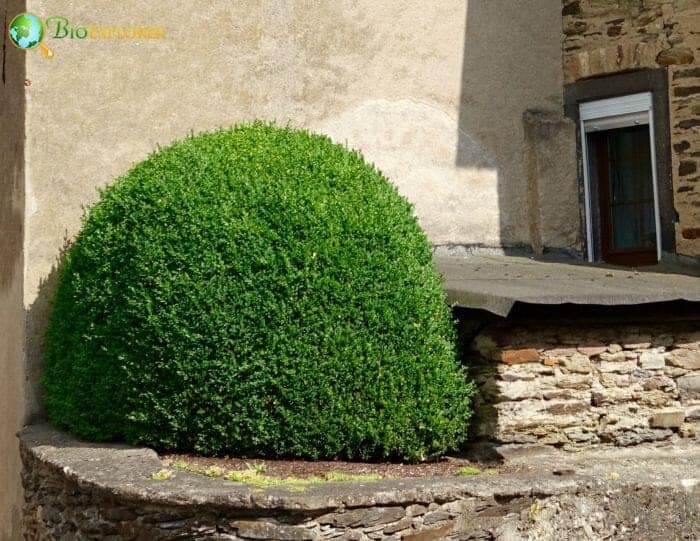
Some species under the Buxales order manifest economic importance as ornamental plants or their wood. The following are examples of the species under this order.
- Common box or European box[8] – This species is a popular hedge plant in parks and gardens.
- Balearic box[9] – The Balearic box is used as a garden plant.
- Korean Boxwood[10] – Buxus sinica is commonly planted as a privacy screen, border plant, or rock garden plant.
- Allegheny spurge[11] is a popular groundcover commonly used in gardens and landscaping.
- Japanese Pachysandra[12] – The plant is trendy for landscaping.
- Sweet box or Christmas box[13] – This plant is a beautiful shrub for the garden.
- Himalayan Sweet box[14] – This plant is used as a groundcover and shrub border.
- Styloceras kunthianum
- Styloceras laurifolium[15] -The wood of the species is used locally for joinery.
![]()
Cite this page
Bio Explorer. (2026, January 4). Order Buxales / Boxwood Flowers. https://www.bioexplorer.net/order-buxales/
